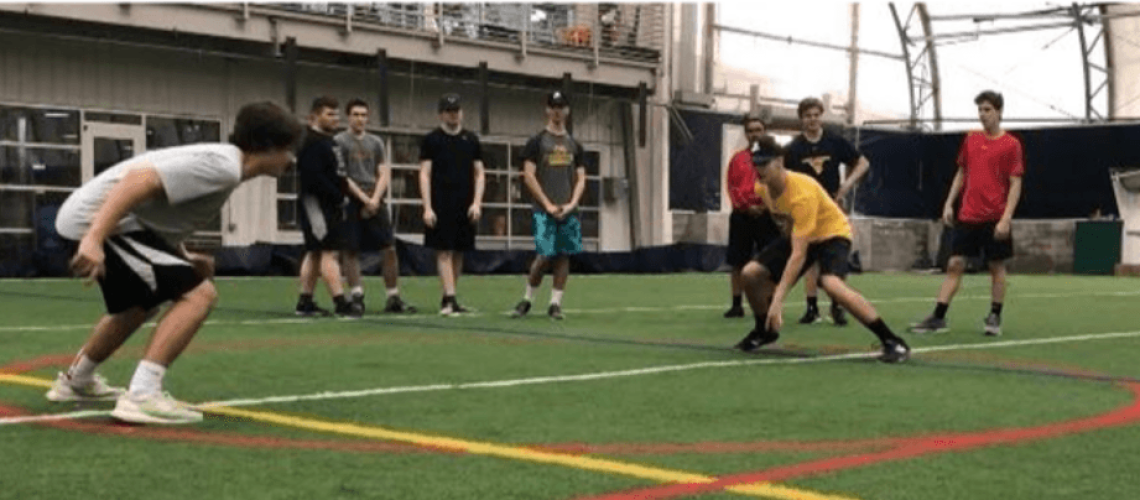by Ryan Leibreich
Director of Strength and Conditioning, Pro Performance RX/Brooke HS/South Middle School, West Virginia.
“If you’re not first, you’re last” is a funny quote from a great movie (Ricky Bobby, “Talladega Nights”), but it also could not be more true when it comes to sports.
You need to be able to react faster than your opponent. Reacting faster is accomplished by quickly processing incoming information and moving specifically to that perception of that information. When we correctly process information and move to the correct position, we end up in the best place to be successful. Some inherent genetic traits can not be changed. However, from a strength and conditioning standpoint, we will discuss the ones we can and how we prepare our athletes to decrease the time to process information and react faster.
Three basic concepts concerning reaction
How reaction works and what you need to know:
1. Filter out useful and non-useful information.
First, we can only process and internalize a limited amount of information. The neural network in your brain and myelination of neurons are responsible for this processing. The more you get exposed to specific information, the quicker you can recall that information. An example is how fast games can feel when you are a freshman vs. a senior. As a freshman, you are taking in a lot of new situations and thoughts that are not always important to the task at hand. Seniors are more experienced and acclimated to the same exposure to a stimulus.
2. Thorough understanding of the rules of the game you are playing.
Second, the more you’re exposed to information, the better you can manipulate the situation. It allows the little tips and tricks to put yourself in the best position for success. Think of the 2-minute drill in football and how coaches and players manage the clock a lot differently. You generally react better and faster when you know the game’s rules and how to play within them.
3. Adaptability
Third, we always have to be adaptable — where we realize things change. This adaptability is because you won’t worry about the last situation and will focus on the one present. When you accept and understand that not every situation is created equal, you will be a step ahead. This mindset can be a game changer for high school and middle school athletes to talk to them about adaptability and reframing situations.
Developing the Training
Diving into the nuts and bolts, we break down a few elements of what we utilize in each drill. In this section, we will break it down and then build it together in the next. Below are some things to consider when putting drills together:
Stimulus
Auditory/Verbal Optical/Visual
Mixing auditory and verbal
Position
Standing, staggered, ½ kneeling, tall kneeling, laying on the ground, etc.
Direction
Same, opposite, diagonal, backward.
Color
1,2,3 or 4 different colors
Open vs. Closed Drills
Open – no end predetermined.
Closed – set end to the game.
Game Development: Developing the Layers
Many of the drills are ones that you probably use daily. All of them are great. We now have a system and a scheme to implement them with more intent and purpose to get the best results out of our athletes.
We are broken up into tiers of easiest to hardest. For new athletes and teams, we typically utilize tier 1 for an entire semester before we add tier 2. We switch back and forth between all tiers for our older athletes to keep it fun and engaging.
Tier one = 1 cue = visual or audible command
Tier two = 2 cues = 1 visual & 1 verbal
Tier three = 2 cues, with 1 being the opposite of what’s asked. For example, right means to go left.
Drills We Use Everyday
Tier 1
Visual – Tennis ball drop
Set up one come 3-5 yards away
Hold the tennis ball at shoulder height, drop from standing staggered stance, ear height for half kneeling facing forward.
Hold above head for half kneeling lateral facing https://youtu.be/zHyKJ_7_ouw
Verbal – Chase Drills
One athlete lays on the group or any start position. The other athlete starts 3-5 yards behind.
On ‘go,’ athlete 2 chases athlete one and tries to tag them. https://youtu.be/TB9bwKy3bJs
Tier 2 – Verbal and Visual
Cone Reaction 1 v 1
Athletes must hear the cone’s director or color and react to the correct spot. Right, blue, left, red Etc.
Mirror Drill
This drill should be familiar to most.
Athlete one tries to move, so athlete 2 cannot mimic movement patterns. When that happens, the drill is over. Reset and start again.
Tier 3
Rock Paper Scissors
3 cones.
Athletes stand — one in the middle. The other two are 5 yards apart in either direction.
Rock/papers/scissors
The winner takes off in either direction Loser chases
The goal is to tag the other person before 5 yards or escape. https://youtu.be/q9RnvXN1Kew
The Best Part
Your high school and middle school athletes will love these drills. They have the elements of competition and fun; hidden inside are the specific skills you are trying to develop—nothing like getting two birds with one stone. Kids will ask when they are getting to do them and always leave with a smile. We often do these at the end of class, so they leave on the best part of their day.
Summary – Something to think about
If you take the foundation of how we train reaction, you can create endless games that follow the principles and reinforce reaction.
Have fun. The more fun you make it, the better the results will be. Also, listen to your athlete’s suggestions. Some of our best variations came from listening to the athletes and what they like and don’t like.


